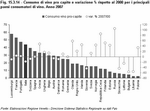
Chapter 15
Agriculture evolves, Veneto is in step
15.1 New opportunities for agricultural farms (Note 1)
The changing international financial scenario has created a new agricultural entrepreneur who is not only focused on the production of foodstuffs, but is also capable of performing on the global market. In such a framework, the new challenges of the modern world require a significant effort to adapt, above all in the agricultural sector which has been penalised for its limited dynamism and scarce tendency for innovation. On the other hand, however, such challenges can present opportunities for those producers willing to grasp them by adapting their way of doing business.
These new opportunities / criticalities concentrate around certain themes, among the most important of which are globalisation, the quality and intangible value of the product, agriculture and technology, business networks and entrepreneurship in the agricultural sector.
These closely linked themes were developed in a study performed by Veneto Agricultura (Note 2) in April. Below is a summary of such themes.
This situation is posing serious and urgent questions concerning the reformulation of sector policies that influence agricultural development systems such as that of the individual farms and businesses. Critical features such as production chain relations, organisation and positioning on markets, collaboration networks and innovation thus become central factors in the management of farms and characteristic and driving elements of the agri-food sector. The international competitive context demands entrepreneurial ability, decisional flexibility, a rapid reaction to change, growth, innovation, organisation and development of the production chain and network. Several pioneering agricultural farms from the region of Veneto have moved in this direction, pursuing a constant qualitative increase in their products, linked to improvements in farms organisation, innovation, and optimisation of production factors, while also investing in marketing and the sales network directed to both close and distant markets.
The globalisation phenomenon is also seriously influencing the economy of Italy and Veneto, a strong point of which is orientation towards export. In 2011, an increase in exports from Veneto was registered alongside significant increases in the exportation of products from the agri-food and beverage industry, among which it is worth highlighting the 1.3 billion euros made in the international sale of wines from Veneto. In contrast, the exportation of unprocessed agricultural and fishing products from Veneto dropped by 2.6%.
It therefore appears evident that the Veneto agricultural system has high-value intrinsic characteristics which can be further enhanced and developed in order for them to be transformed into a competitive advantage on an international level. Production specialisation in several niche products including wines, cheeses and fruit and vegetables have provided a certain value but up to now this has been predominantly limited to a local level. In other words, the tendency is to sell only a few tens or hundreds of kilometres from the production location, partly in response to the need to shorten the production chain (direct sale and farmers' markets). Nevertheless, examples of success have mainly been observed in the winemaking sector; a testimony to the fact that globalisation offers made in Italy products the opportunity to become recognised and sold even in distant markets.
Business networks may perhaps have a decisive role in helping the region of Veneto to surpass its territorial boundaries and promote business relations for small entrepreneurial farms.
Thus the ability not only to produce excellent products but to concretise collaborative relations for shared development projects regains importance; both to reach a critical mass, but also to allow specialist energy to be focused on marketing and on the sales network. In this context, value creation is determined by knowledge. It is human capital which, when combined with a high level of formal education translated into talent, ability and creativity, becomes a critical element for success. In the past, knowledge was almost exclusively directed towards researching how best to allocate resources in order to achieve efficiency. Today, this research is aimed at producing new services and new products, which anchor the physical, material goods to intangible elements, desires, experiences and meanings. Across the world, the made in Italy brand represents high quality, luxurious niche products within the clothing, furnishings and automotive sectors. In the future, the brand will be able to establish itself even more so for many agri-food products. The intangible values drawn from our food culture, which include tradition, handcrafting, the connection with the earth, the Countryside and the brand can be sold across the world, amplifying diffusion and the consumer pool across borders and time, and thus multiplying value.
One of the aspects upon which the most innovative businesses focus in order to gain the competitive advantage over others, is the supply of 'quality products'. But what quality are we referring to? Organoleptic quality, commercial quality or technological quality? And how does one achieve said quality? The road which transforms 'quality' into business 'opportunity' varies, much like the concept of quality itself. Today, this concept is increasingly understood as a vehicle through which to respond to the expressed and latent needs of the consumer. In fact, quality is no longer understood as simply an intrinsic element of the product, but more as an attribute which is added to the characteristics of the product itself.
It is moreover possible to confirm that the new market is no longer moved by needs but by desires; the need thus arises for producers to satisfy the desires of consumers instead of satisfying their needs. It has in fact been clearly observed from the market research that consumption, including that of agri-food products, is becoming increasingly linked to the consumption of meaning, emotion and intangible experiences instead of the consumption of material goods. This is 'dematerialisation', in other words the movement from an economy of needs to an economy of desires, using knowledge as a shared and consistent resource.
Several farms and businesses have grasped these changes in consumer consumption and purchasing style for food products and have focused on offering ready-made products. Others have concentrated on differentiation, others on the attribution of 'values' or 'meanings' connected to well-being, environmental respect and tradition to the product. Several have focused on satisfying the needs of the final consumer, others have instead focused more carefully on the needs of intermediate clients present in the production chain. The agricultural entrepreneur generally has intermediate clients as its main referents: wholesalers, Large-scale Organised Distributors (LOD), shop owners or the industry. However, all players in the agricultural production chain have the final consumer as their point of reference, and they should therefore capture the explicit and latent needs of the consumer: what the client wants to consume and how he uses the products. The entrepreneur should understand the consumer's lifestyle.
This means harnessing the opportunity to satisfy the needs of those consumers who require ready-made products, for example, or fulfilling the requirements of LODs concerning product quantity and qualitative standards, by introducing technical and organisational innovations to the farms and business, investing in the creation of transformation platforms and in production and delivery organisation, which must be carried out in only a few hours, maintaining the cold chain.
It is therefore about understanding how to use modern distribution chains and adopting the necessary product innovations in order to be competitive, adopting methods and procedures which involve certifications, controls, labelling, traceability, segregation and the packaging of products.
Today, after 10,000 years or so of farming history, it is possible to identify two paradigms of technological use.
The first is the hard technology paradigm: the legend of technology applied to agriculture, from innovation research to the spasmodic use of ever greater technological 'power' in order to increase agricultural productivity. In fact, technology is translated into economic value the moment that an increase in per hectare or per working unit productivity is labelled as the objective. This hard technology or industrial agriculture paradigm represented an example of technological success for the industrialised world, not only in relation to the ability to produce more food using less land, but also and more importantly, for the capacity to produce much more food using less manpower. This development model continues to prevail even today. Despite high energy and economic costs and the heavy repercussions on the climactic, environmental and social level, the most advanced technologies, whether mechanical or biological, and facilitated by chemical and genetic technology, dominate the agriculture of industrialised Countries and continually stimulate new innovative drives in the technology sector.
The second paradigm is that of soft technology. Over the last decades, the agricultural sector of industrialised Countries seems to have become a victim of its own past technological success. It appears to be in difficulty when faced with the economic and role development which the agri-food sector system has assumed in the markets, predominantly in the most developed Countries. In fact at present, 'producing more food' is no longer the only priority, given that the constant availability of food is now considered - sometimes erroneously - to have been achieved. Other criteria have gained importance and this change in perceptions has also altered the definition of priorities in terms of agricultural technological development. Technological development appears to be in transition between a technological application driven towards 'power' towards a more 'mild' technology which is more efficient and profitable. There is a strong connection between social and demographic changes and agri-food demand and the diffusion of new technologies across the agri-food sector. Through experiments and the introduction of innovations during the various phases of the productive process, the agri-food sector is attempting to stay in step, if not anticipate, the development of consumer needs, which are increasingly dictating the content, orientation and paths of development. In a developed society, when you pay for a food product, you are paying above all for its 'service' attributes and its convenience is understood in relation to its ability to satisfy consumer desires linked, for example, to the need to reduce the time taken for food preparation ('ready-to-eat', pre-cooked and frozen products, ready-prepared vegetables, single servings, etc.), to satisfy quality and food safety requirements (health and/or diet foods, light, functional or enriched foods, organic produce, etc.), and ensure accessibility and conservation (packaging, logistics, traceability, etc.).
The most innovative agricultural farms have already realised that the greatest marginal value attainable from technology lies in its application during the phases which precede or follow agricultural production: research (genome, biotechnology and nano-technology), harvesting, processing, conservation and transportation of goods (automation of manufacturing processes, packaging, marketing, logistics, IT, etc.) or alternative sectors (use of biomass for energy needs, photovoltaics, etc.). Due to the fact that in these contexts, technology leads to differentiation, the industrialisation of food connected with agriculture constitutes a winning competitive advantage ensuring its permanence and protection on the market.
Suffice to recall the consolidated presence of the agricultural cooperative system in Veneto, a story which began at the end of the Nineteenth century when groups of farmers decided to come together in order to overcome the size-related restrictions of their property and provide themselves with adequate productive structures. It is an ever-present issue if we recall that the break-down of the production base and the exiguity of average farm surface area represent some of the most important limiting factors on entrepreneurial growth in the primary sector in the Veneto.
In years gone by, the need to overcome the criticalities and inefficiencies resulting from size-related restrictions created conditions suitable for the birth of many Cooperatives, Consortia and Associations. These early networks of producers, capable of concentrating the product, creating large economies and providing the investments needed, sometimes evolved into distribution chain networks, which partly or completely focused on the various segments of consumables production. Participation in business networks provides the opportunity to go beyond the mere productive sphere by establishing stable relationships with distributors, importers and buyers and bringing to life suitable structures for promotion and commercialisation.
One of the merits of the cooperatives, consortia and associations in the agricultural sector has been to allow for farm fragmentation to be overcome without relinquishing individualism: one of the main characteristics of the entrepreneurial fabric of Veneto. In fact, the network allows the small entrepreneur to salvage control of his/her business, indeed to stay at its head, while at the same time broadening horizons, possibilities and opportunities: thinking big without losing autonomy.
On the other hand, it is worth highlighting that many farms and business and territorial networks in the Veneto agri-food sector subsist based upon relations between partners which can only be partially considered true network connections. Often these networking systems are obsolete and/or inadequate to the needs of the most innovative businesses, which require more modern and incisive forms of aggregation. In effect, these are territorial networks in which specialist expertise or risk sharing is rarely found, and in which the need to find indirect solutions which are acceptable to all partners often obstructs the realisation of strategies suitable for the innovators.
The networking experiences consolidated within the agricultural world are, in many cases, demonstrating their limitations within an increasingly complex economic backdrop in which business organisation requires flexibility and outsourcing. The modern concept of the network cannot then be understood as a collection of individuals who wish to become active parts of a bigger system, all roughly performing the same role using the same expertise. A different approach is needed: the network should act as a system of relationships between operators who accept their interdependence, and the need to divide costs, risks and investments, and specialise in certain functions in order to share the excellence of their professionalism with their partners. The functions in which the agricultural entrepreneur struggles to be professional and competitive, particularly those activities which fall outside of production concerning segments further along in the production chain such as marketing, communication and logistics, can be delegated to other players in the network.
This path presupposes the business re-thinking its own role: a cultural change before a management change.
Some farms and businesses have done so by starting from their own history and specialisation, launching it into the future by revising their own experiences towards new objectives. This approach allows them to tackle the problem of innovation, quality, organisation and client and supplier relations, allowing room for the personal experiences of the individuals involved, the inter-personal relationships developed, and the interwoven networks which create a common space for the exploration of possibilities. This means that farms of today wishing to become enterprises must succeed in rethinking the activities of the past in search of new opportunities and innovation.
Other farms and businesses have predominantly worked on their differences and on the ability to interpret these positively, so as to transform them into valuable factors, responding to questions such as: what can I do that is unique? What can I do differently starting from what I know how to do? How can I integrate my specialisation into a production chain in an innovative way? How can my farm stand out from the others?
The future does not thus emerge on its own, neither can it be derived from automatisms put in place by others. Even the farmers must create their own future. And it is here that business expectations should be brought into play, mediated by ideas, by the desire to take risks, by making investments, but above all, by the ability to recognise the farm or business's uniqueness through the history that it has created. It is this uniqueness which must acquire useful value for others (Why am I different? Why will my uniqueness be of value to others?)
It is possible to deduce a common characteristic from the entrepreneurial success stories of many industrial and service businesses: that which distinguishes them is not only their attention to quality, modernity or the technological level of the goods and services put on the market, but the innovation (uniqueness) incorporated into the product, which creates a basis for exploration into the future possibilities of an increasingly complex and interconnected society, both on a local and international level. This is becoming possible due to farm and businesses' increasing openness to reciprocal collaboration in accordance with a network model which also includes the final consumer. In this way, innovation is no longer the result of an isolated stroke of genius from one individual or business, but benefits from converging attitudes on the part of many individuals which constitute the hub of relational networks, aimed towards the development of new possibilities: the characteristics of an economic operation that economists now refer to as 'an economy of knowledge'.
Thus the agricultural entrepreneur does not only need to innovate in order to improve its productive efficiency through renovating its product, updating productive processes and machines, improving the organisation, etc., but he must reply not only to cost but to the cultural needs of the client, the markets and the consumer.
The possibilities open to the Venetian agricultural entrepreneur in this sense are numerous, and are not only linked to the strength of typical IGP and DOC products, which are demonstrating true potential on global markets, but also refer to those opportunities presented by multi-functionality, specialisation and short or niche production chains.
These new opportunities / criticalities concentrate around certain themes, among the most important of which are globalisation, the quality and intangible value of the product, agriculture and technology, business networks and entrepreneurship in the agricultural sector.
These closely linked themes were developed in a study performed by Veneto Agricultura (Note 2) in April. Below is a summary of such themes.
Globalisation
In relatively recent times, the 'globalisation' phenomenon has also involved, and with a strong impact, the production and marketing systems of goods destined for human consumption, thus causing an increase in consumption, production and exchange. This situation is posing serious and urgent questions concerning the reformulation of sector policies that influence agricultural development systems such as that of the individual farms and businesses. Critical features such as production chain relations, organisation and positioning on markets, collaboration networks and innovation thus become central factors in the management of farms and characteristic and driving elements of the agri-food sector. The international competitive context demands entrepreneurial ability, decisional flexibility, a rapid reaction to change, growth, innovation, organisation and development of the production chain and network. Several pioneering agricultural farms from the region of Veneto have moved in this direction, pursuing a constant qualitative increase in their products, linked to improvements in farms organisation, innovation, and optimisation of production factors, while also investing in marketing and the sales network directed to both close and distant markets.
The globalisation phenomenon is also seriously influencing the economy of Italy and Veneto, a strong point of which is orientation towards export. In 2011, an increase in exports from Veneto was registered alongside significant increases in the exportation of products from the agri-food and beverage industry, among which it is worth highlighting the 1.3 billion euros made in the international sale of wines from Veneto. In contrast, the exportation of unprocessed agricultural and fishing products from Veneto dropped by 2.6%.
It therefore appears evident that the Veneto agricultural system has high-value intrinsic characteristics which can be further enhanced and developed in order for them to be transformed into a competitive advantage on an international level. Production specialisation in several niche products including wines, cheeses and fruit and vegetables have provided a certain value but up to now this has been predominantly limited to a local level. In other words, the tendency is to sell only a few tens or hundreds of kilometres from the production location, partly in response to the need to shorten the production chain (direct sale and farmers' markets). Nevertheless, examples of success have mainly been observed in the winemaking sector; a testimony to the fact that globalisation offers made in Italy products the opportunity to become recognised and sold even in distant markets.
Business networks may perhaps have a decisive role in helping the region of Veneto to surpass its territorial boundaries and promote business relations for small entrepreneurial farms.
Thus the ability not only to produce excellent products but to concretise collaborative relations for shared development projects regains importance; both to reach a critical mass, but also to allow specialist energy to be focused on marketing and on the sales network. In this context, value creation is determined by knowledge. It is human capital which, when combined with a high level of formal education translated into talent, ability and creativity, becomes a critical element for success. In the past, knowledge was almost exclusively directed towards researching how best to allocate resources in order to achieve efficiency. Today, this research is aimed at producing new services and new products, which anchor the physical, material goods to intangible elements, desires, experiences and meanings. Across the world, the made in Italy brand represents high quality, luxurious niche products within the clothing, furnishings and automotive sectors. In the future, the brand will be able to establish itself even more so for many agri-food products. The intangible values drawn from our food culture, which include tradition, handcrafting, the connection with the earth, the Countryside and the brand can be sold across the world, amplifying diffusion and the consumer pool across borders and time, and thus multiplying value.
The quality and intangible value of the product
The excellence of the entrepreneurs, whether in the agricultural sector or not, lies in their ability to grasp any opportunity provided by the market, to understand how to predict the needs of the client and translate these into new products and services. This is, in short, what makes businesses innovative; this is what opens doors. One of the aspects upon which the most innovative businesses focus in order to gain the competitive advantage over others, is the supply of 'quality products'. But what quality are we referring to? Organoleptic quality, commercial quality or technological quality? And how does one achieve said quality? The road which transforms 'quality' into business 'opportunity' varies, much like the concept of quality itself. Today, this concept is increasingly understood as a vehicle through which to respond to the expressed and latent needs of the consumer. In fact, quality is no longer understood as simply an intrinsic element of the product, but more as an attribute which is added to the characteristics of the product itself.
It is moreover possible to confirm that the new market is no longer moved by needs but by desires; the need thus arises for producers to satisfy the desires of consumers instead of satisfying their needs. It has in fact been clearly observed from the market research that consumption, including that of agri-food products, is becoming increasingly linked to the consumption of meaning, emotion and intangible experiences instead of the consumption of material goods. This is 'dematerialisation', in other words the movement from an economy of needs to an economy of desires, using knowledge as a shared and consistent resource.
Several farms and businesses have grasped these changes in consumer consumption and purchasing style for food products and have focused on offering ready-made products. Others have concentrated on differentiation, others on the attribution of 'values' or 'meanings' connected to well-being, environmental respect and tradition to the product. Several have focused on satisfying the needs of the final consumer, others have instead focused more carefully on the needs of intermediate clients present in the production chain. The agricultural entrepreneur generally has intermediate clients as its main referents: wholesalers, Large-scale Organised Distributors (LOD), shop owners or the industry. However, all players in the agricultural production chain have the final consumer as their point of reference, and they should therefore capture the explicit and latent needs of the consumer: what the client wants to consume and how he uses the products. The entrepreneur should understand the consumer's lifestyle.
This means harnessing the opportunity to satisfy the needs of those consumers who require ready-made products, for example, or fulfilling the requirements of LODs concerning product quantity and qualitative standards, by introducing technical and organisational innovations to the farms and business, investing in the creation of transformation platforms and in production and delivery organisation, which must be carried out in only a few hours, maintaining the cold chain.
It is therefore about understanding how to use modern distribution chains and adopting the necessary product innovations in order to be competitive, adopting methods and procedures which involve certifications, controls, labelling, traceability, segregation and the packaging of products.
Agriculture and technology
Since agriculture was born, since man developed this new knowledge, from that moment, it was observation, experimentation, practice and experience which has led to improvement, perfection and the birth of new agricultural techniques, and above all, new technology. Technology is nothing other than the concretisation of knowledge, the putting into practice of acquired knowledge using specific procedures.Today, after 10,000 years or so of farming history, it is possible to identify two paradigms of technological use.
The first is the hard technology paradigm: the legend of technology applied to agriculture, from innovation research to the spasmodic use of ever greater technological 'power' in order to increase agricultural productivity. In fact, technology is translated into economic value the moment that an increase in per hectare or per working unit productivity is labelled as the objective. This hard technology or industrial agriculture paradigm represented an example of technological success for the industrialised world, not only in relation to the ability to produce more food using less land, but also and more importantly, for the capacity to produce much more food using less manpower. This development model continues to prevail even today. Despite high energy and economic costs and the heavy repercussions on the climactic, environmental and social level, the most advanced technologies, whether mechanical or biological, and facilitated by chemical and genetic technology, dominate the agriculture of industrialised Countries and continually stimulate new innovative drives in the technology sector.
The second paradigm is that of soft technology. Over the last decades, the agricultural sector of industrialised Countries seems to have become a victim of its own past technological success. It appears to be in difficulty when faced with the economic and role development which the agri-food sector system has assumed in the markets, predominantly in the most developed Countries. In fact at present, 'producing more food' is no longer the only priority, given that the constant availability of food is now considered - sometimes erroneously - to have been achieved. Other criteria have gained importance and this change in perceptions has also altered the definition of priorities in terms of agricultural technological development. Technological development appears to be in transition between a technological application driven towards 'power' towards a more 'mild' technology which is more efficient and profitable. There is a strong connection between social and demographic changes and agri-food demand and the diffusion of new technologies across the agri-food sector. Through experiments and the introduction of innovations during the various phases of the productive process, the agri-food sector is attempting to stay in step, if not anticipate, the development of consumer needs, which are increasingly dictating the content, orientation and paths of development. In a developed society, when you pay for a food product, you are paying above all for its 'service' attributes and its convenience is understood in relation to its ability to satisfy consumer desires linked, for example, to the need to reduce the time taken for food preparation ('ready-to-eat', pre-cooked and frozen products, ready-prepared vegetables, single servings, etc.), to satisfy quality and food safety requirements (health and/or diet foods, light, functional or enriched foods, organic produce, etc.), and ensure accessibility and conservation (packaging, logistics, traceability, etc.).
The most innovative agricultural farms have already realised that the greatest marginal value attainable from technology lies in its application during the phases which precede or follow agricultural production: research (genome, biotechnology and nano-technology), harvesting, processing, conservation and transportation of goods (automation of manufacturing processes, packaging, marketing, logistics, IT, etc.) or alternative sectors (use of biomass for energy needs, photovoltaics, etc.). Due to the fact that in these contexts, technology leads to differentiation, the industrialisation of food connected with agriculture constitutes a winning competitive advantage ensuring its permanence and protection on the market.
Business networks
Broadly speaking, network is not a recent invention. In our system of production, networks have been acknowledged for a long time and in the evolution of relations among businesses, it is worth highlighting that the agri-food sector has often taken centre-stage, if not a pioneering role, in the creation of networks.Suffice to recall the consolidated presence of the agricultural cooperative system in Veneto, a story which began at the end of the Nineteenth century when groups of farmers decided to come together in order to overcome the size-related restrictions of their property and provide themselves with adequate productive structures. It is an ever-present issue if we recall that the break-down of the production base and the exiguity of average farm surface area represent some of the most important limiting factors on entrepreneurial growth in the primary sector in the Veneto.
In years gone by, the need to overcome the criticalities and inefficiencies resulting from size-related restrictions created conditions suitable for the birth of many Cooperatives, Consortia and Associations. These early networks of producers, capable of concentrating the product, creating large economies and providing the investments needed, sometimes evolved into distribution chain networks, which partly or completely focused on the various segments of consumables production. Participation in business networks provides the opportunity to go beyond the mere productive sphere by establishing stable relationships with distributors, importers and buyers and bringing to life suitable structures for promotion and commercialisation.
One of the merits of the cooperatives, consortia and associations in the agricultural sector has been to allow for farm fragmentation to be overcome without relinquishing individualism: one of the main characteristics of the entrepreneurial fabric of Veneto. In fact, the network allows the small entrepreneur to salvage control of his/her business, indeed to stay at its head, while at the same time broadening horizons, possibilities and opportunities: thinking big without losing autonomy.
On the other hand, it is worth highlighting that many farms and business and territorial networks in the Veneto agri-food sector subsist based upon relations between partners which can only be partially considered true network connections. Often these networking systems are obsolete and/or inadequate to the needs of the most innovative businesses, which require more modern and incisive forms of aggregation. In effect, these are territorial networks in which specialist expertise or risk sharing is rarely found, and in which the need to find indirect solutions which are acceptable to all partners often obstructs the realisation of strategies suitable for the innovators.
The networking experiences consolidated within the agricultural world are, in many cases, demonstrating their limitations within an increasingly complex economic backdrop in which business organisation requires flexibility and outsourcing. The modern concept of the network cannot then be understood as a collection of individuals who wish to become active parts of a bigger system, all roughly performing the same role using the same expertise. A different approach is needed: the network should act as a system of relationships between operators who accept their interdependence, and the need to divide costs, risks and investments, and specialise in certain functions in order to share the excellence of their professionalism with their partners. The functions in which the agricultural entrepreneur struggles to be professional and competitive, particularly those activities which fall outside of production concerning segments further along in the production chain such as marketing, communication and logistics, can be delegated to other players in the network.
This path presupposes the business re-thinking its own role: a cultural change before a management change.
Entrepreneurship in agriculture
Recognising an opportunity for the agriculture of tomorrow within the development of modern entrepreneurship is not a mere hope: it is a necessity. The agricultural entrepreneur is increasingly faced with varying prices, increasing production costs and international competition. How are these challenges to be overcome?Some farms and businesses have done so by starting from their own history and specialisation, launching it into the future by revising their own experiences towards new objectives. This approach allows them to tackle the problem of innovation, quality, organisation and client and supplier relations, allowing room for the personal experiences of the individuals involved, the inter-personal relationships developed, and the interwoven networks which create a common space for the exploration of possibilities. This means that farms of today wishing to become enterprises must succeed in rethinking the activities of the past in search of new opportunities and innovation.
Other farms and businesses have predominantly worked on their differences and on the ability to interpret these positively, so as to transform them into valuable factors, responding to questions such as: what can I do that is unique? What can I do differently starting from what I know how to do? How can I integrate my specialisation into a production chain in an innovative way? How can my farm stand out from the others?
The future does not thus emerge on its own, neither can it be derived from automatisms put in place by others. Even the farmers must create their own future. And it is here that business expectations should be brought into play, mediated by ideas, by the desire to take risks, by making investments, but above all, by the ability to recognise the farm or business's uniqueness through the history that it has created. It is this uniqueness which must acquire useful value for others (Why am I different? Why will my uniqueness be of value to others?)
It is possible to deduce a common characteristic from the entrepreneurial success stories of many industrial and service businesses: that which distinguishes them is not only their attention to quality, modernity or the technological level of the goods and services put on the market, but the innovation (uniqueness) incorporated into the product, which creates a basis for exploration into the future possibilities of an increasingly complex and interconnected society, both on a local and international level. This is becoming possible due to farm and businesses' increasing openness to reciprocal collaboration in accordance with a network model which also includes the final consumer. In this way, innovation is no longer the result of an isolated stroke of genius from one individual or business, but benefits from converging attitudes on the part of many individuals which constitute the hub of relational networks, aimed towards the development of new possibilities: the characteristics of an economic operation that economists now refer to as 'an economy of knowledge'.
Thus the agricultural entrepreneur does not only need to innovate in order to improve its productive efficiency through renovating its product, updating productive processes and machines, improving the organisation, etc., but he must reply not only to cost but to the cultural needs of the client, the markets and the consumer.
The possibilities open to the Venetian agricultural entrepreneur in this sense are numerous, and are not only linked to the strength of typical IGP and DOC products, which are demonstrating true potential on global markets, but also refer to those opportunities presented by multi-functionality, specialisation and short or niche production chains.
Which transformations have characterised Veneto agriculture over the past years? Which new scenarios are taking shape? Which opportunities can be seized?
Several of the most important responses can be found in the data of the last general agricultural census, which took place in October 2010 and is capable of highlighting what has occurred over the past 10 years (Note 3).
Over the following pages are the primary results, compared with those of the 2000 Census: before analysing them, several conditions should be specified regarding the nature of the data which was analysed (Note 4). The provisional data available is attributed to the region or autonomous province in which the business is located (Note 5), independent of the residence of the owner and of the Census Office of reference for that agricultural farm or business. Any eventual and necessary off-sets between the regions, provinces and towns of the surveyed areas can only be undertaken using the definitive data.
On 24th October 2010, there were 120,735 agricultural farms and businesses present in Veneto (Note 6), more than a 30% reduction on the 2000 figures, across a utilised agricultural area (UAA) of 806,319 hectares, with a reduction of 5%. This data confirms the resizing process which has been in course for several decades already, which is causing the concentration of Veneto agricultural land and farms.
The direct consequence has been an increase in average surface area which has moved from 4.8 hectares in 2000 to 6.7 at present, although still below the Italian average (7.9 ha) and the Europe-27 average (17.9 ha). (Figure 15.2.1)
The net drop in the number of farms and businesses is a phenomenon which involves the entire peninsula indiscriminately (the Italian average is down by 32.2%). The national UAA, on the other hand, has fallen by almost 2.3% and has actually risen in some regions, predominantly in the first three which have higher values (Sicily, Puglia and Sardinia).
The average UAA has consequently grown with a concentration of higher values in the northern regions, where farms are historically more inclined towards entrepreneurialism. (Figure 15.2.2)
Moving into more detail, in Veneto almost half the farms lie in the provinces of Padua and Treviso, with 25% and 24% of the total respectively, while it is the province of Verona which boasts the largest slice of the utilised agricultural area (21%). (Figure 15.2.3)
The province which registers the greatest increase in average UAA is Belluno, which is characterised by wide fields and pastures equivalent to almost a third of the Veneto total. In 2000, the farms of this area had among the highest UAAs in the region, even if in 2010 the number of farms dropped and a lower reduction occurred in the in UAA. (Figure 15.2.4)
Going into greater geographical detail, in terms of agricultural region, the greatest loss in businesses is concentrated in the entire area of the foothills, in the areas of Venice and Cadore. (Figure 15.2.5)
Many of these areas witnessed a significant hydro geological risk over the past years and the abandonment of the land by agricultural farms could deprive it of some of the most important safeguards for its care and protection.
In Veneto arable crops prevail: with over half a million hectares, it covers 70% (in Italy, little more than half) of UAA, fields and pastures follow with 16% (almost 27% in Italy), and agricultural woods with 13.4% (18.4% on a national level). Both in Veneto and in Italy, family-run vegetable gardens cover a marginal share of UAA, equal in both cases to 0.2% (Figure 15.2.6).
It is these fields, pastures and allotments which have witnessed the most consistent reduction in area, -20.1% and -23.6% respectively, compared to substantial stability for arable crops (-2%) and agricultural trees (0.4%), the latter due to the main tree-grown crop cultivated in Veneto: grape vines, which over the last 10 years have lost around -0.1% of surface area, equivalent to its 73,708 hectares. (Figure 15.2.7)
In this way, the Veneto grape vine has increased its importance across the Italian territory, reaching almost 12% of the national total. For every 100 hectares of cultivated trees in our region, almost 70 are grape vines. On the other hand, the number of farms cultivating this type of crop over the past 10 years has more than halved, in coherence with the phenomena of specialisation and concentration of agricultural land which has involved the entire Country. Although doubled, the average UAA per company for grape vines remains below the regional average, reaching a value of two hectares.
In detailed reference to each province, Padua, Treviso and Venice host more than two thirds of arable crop farms in Veneto, while the biggest proportion of agricultural tree crop farms is distributed between Treviso and Verona (predominantly grape vines): over half of the Veneto total resides in these two provinces. (Figure 15.2.8)
With regard to livestock breeding (Note 7), in 2010 Veneto was among the regions with the highest number of livestock breeding farms in Italy (in third place after Lombardy and Sardinia), as was the case ten years beforehand. The specialisation most represented in Italy, as in Veneto, is cattle breeding. More than half the livestock breeding farms in Italy raise this species of animal, the percentage of which is 65% in our region. In fact, Veneto is one of three regions in Italy, together with Lombardy and Piedmont, with the highest number of head of cattle and farms (Figure 15.2.9)
Veneto also stands out on a national level for the number of head of poultry bred: with over 8 million head and almost three thousand farms and businesses, it is by far the first among Italian regions with this specialisation. A similar phenomenon occurs for rabbits: with over two and a half million head and in first place again.
Treviso and Padua are two of the provinces with the greatest number of farms also performing with livestock breeding activities, which all together represent almost half of the regional total. (Figure 15.2.10)
As is the case for crops, even in the context of livestock breeding farms, each province has demonstrated its own territorial specialism: the greatest number of cattle farms are concentrated in Treviso, Padua and Vicenza, whereas poultry concentrates in the provinces of Verona and Padua, pig farms are found predominantly in Treviso and Padua, Belluno is distinguished by its sheep farms, Venice and Treviso for buffalo, and Rovigo for its ostrich. (Figure 15.2.11)
Agriculture is one of the essential components within an economic and social context. The importance of this sector is such that failing to sustain it properly would certainly cause a reduction in gross domestic product and, as a consequence, a fall in employment figures in many other directly correlated economic sectors such as the agri-food chain, the tourism-related rural activities sector, transport, and local and public services. The agricultural sector also performs an important role with regard to the environment and territorial protection, possessing the ability to halt the abandonment which too often occurs in rural areas.
The objectives proposed by the European Union, which include increasing competition in the agricultural-forestry sector and improving spaces and quality of life in rural areas through economic diversification and, at the same time, respecting environmental sustainability by promoting local abilities and talents in order to create jobs, will certainly be of importance in protecting this incredibly important activity which is at risk of losing its equilibrium.
Several of the most important responses can be found in the data of the last general agricultural census, which took place in October 2010 and is capable of highlighting what has occurred over the past 10 years (Note 3).
Over the following pages are the primary results, compared with those of the 2000 Census: before analysing them, several conditions should be specified regarding the nature of the data which was analysed (Note 4). The provisional data available is attributed to the region or autonomous province in which the business is located (Note 5), independent of the residence of the owner and of the Census Office of reference for that agricultural farm or business. Any eventual and necessary off-sets between the regions, provinces and towns of the surveyed areas can only be undertaken using the definitive data.
On 24th October 2010, there were 120,735 agricultural farms and businesses present in Veneto (Note 6), more than a 30% reduction on the 2000 figures, across a utilised agricultural area (UAA) of 806,319 hectares, with a reduction of 5%. This data confirms the resizing process which has been in course for several decades already, which is causing the concentration of Veneto agricultural land and farms.
The direct consequence has been an increase in average surface area which has moved from 4.8 hectares in 2000 to 6.7 at present, although still below the Italian average (7.9 ha) and the Europe-27 average (17.9 ha). (Figure 15.2.1)
The net drop in the number of farms and businesses is a phenomenon which involves the entire peninsula indiscriminately (the Italian average is down by 32.2%). The national UAA, on the other hand, has fallen by almost 2.3% and has actually risen in some regions, predominantly in the first three which have higher values (Sicily, Puglia and Sardinia).
The average UAA has consequently grown with a concentration of higher values in the northern regions, where farms are historically more inclined towards entrepreneurialism. (Figure 15.2.2)
Moving into more detail, in Veneto almost half the farms lie in the provinces of Padua and Treviso, with 25% and 24% of the total respectively, while it is the province of Verona which boasts the largest slice of the utilised agricultural area (21%). (Figure 15.2.3)
The province which registers the greatest increase in average UAA is Belluno, which is characterised by wide fields and pastures equivalent to almost a third of the Veneto total. In 2000, the farms of this area had among the highest UAAs in the region, even if in 2010 the number of farms dropped and a lower reduction occurred in the in UAA. (Figure 15.2.4)
Going into greater geographical detail, in terms of agricultural region, the greatest loss in businesses is concentrated in the entire area of the foothills, in the areas of Venice and Cadore. (Figure 15.2.5)
Many of these areas witnessed a significant hydro geological risk over the past years and the abandonment of the land by agricultural farms could deprive it of some of the most important safeguards for its care and protection.
In Veneto arable crops prevail: with over half a million hectares, it covers 70% (in Italy, little more than half) of UAA, fields and pastures follow with 16% (almost 27% in Italy), and agricultural woods with 13.4% (18.4% on a national level). Both in Veneto and in Italy, family-run vegetable gardens cover a marginal share of UAA, equal in both cases to 0.2% (Figure 15.2.6).
It is these fields, pastures and allotments which have witnessed the most consistent reduction in area, -20.1% and -23.6% respectively, compared to substantial stability for arable crops (-2%) and agricultural trees (0.4%), the latter due to the main tree-grown crop cultivated in Veneto: grape vines, which over the last 10 years have lost around -0.1% of surface area, equivalent to its 73,708 hectares. (Figure 15.2.7)
In this way, the Veneto grape vine has increased its importance across the Italian territory, reaching almost 12% of the national total. For every 100 hectares of cultivated trees in our region, almost 70 are grape vines. On the other hand, the number of farms cultivating this type of crop over the past 10 years has more than halved, in coherence with the phenomena of specialisation and concentration of agricultural land which has involved the entire Country. Although doubled, the average UAA per company for grape vines remains below the regional average, reaching a value of two hectares.
In detailed reference to each province, Padua, Treviso and Venice host more than two thirds of arable crop farms in Veneto, while the biggest proportion of agricultural tree crop farms is distributed between Treviso and Verona (predominantly grape vines): over half of the Veneto total resides in these two provinces. (Figure 15.2.8)
With regard to livestock breeding (Note 7), in 2010 Veneto was among the regions with the highest number of livestock breeding farms in Italy (in third place after Lombardy and Sardinia), as was the case ten years beforehand. The specialisation most represented in Italy, as in Veneto, is cattle breeding. More than half the livestock breeding farms in Italy raise this species of animal, the percentage of which is 65% in our region. In fact, Veneto is one of three regions in Italy, together with Lombardy and Piedmont, with the highest number of head of cattle and farms (Figure 15.2.9)
Veneto also stands out on a national level for the number of head of poultry bred: with over 8 million head and almost three thousand farms and businesses, it is by far the first among Italian regions with this specialisation. A similar phenomenon occurs for rabbits: with over two and a half million head and in first place again.
Treviso and Padua are two of the provinces with the greatest number of farms also performing with livestock breeding activities, which all together represent almost half of the regional total. (Figure 15.2.10)
As is the case for crops, even in the context of livestock breeding farms, each province has demonstrated its own territorial specialism: the greatest number of cattle farms are concentrated in Treviso, Padua and Vicenza, whereas poultry concentrates in the provinces of Verona and Padua, pig farms are found predominantly in Treviso and Padua, Belluno is distinguished by its sheep farms, Venice and Treviso for buffalo, and Rovigo for its ostrich. (Figure 15.2.11)
Agriculture is one of the essential components within an economic and social context. The importance of this sector is such that failing to sustain it properly would certainly cause a reduction in gross domestic product and, as a consequence, a fall in employment figures in many other directly correlated economic sectors such as the agri-food chain, the tourism-related rural activities sector, transport, and local and public services. The agricultural sector also performs an important role with regard to the environment and territorial protection, possessing the ability to halt the abandonment which too often occurs in rural areas.
The objectives proposed by the European Union, which include increasing competition in the agricultural-forestry sector and improving spaces and quality of life in rural areas through economic diversification and, at the same time, respecting environmental sustainability by promoting local abilities and talents in order to create jobs, will certainly be of importance in protecting this incredibly important activity which is at risk of losing its equilibrium.
Figure 15.2.1
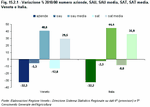
Figure 15.2.2
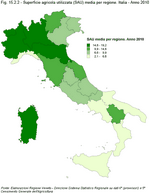
Figure 15.2.3

Figure 15.2.4

Figure 15.2.5
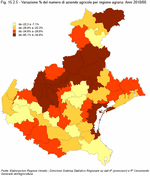
Figure 15.2.6

Figure 15.2.7
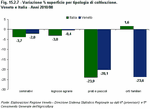
Figure 15.2.8
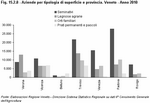
Figure 15.2.9
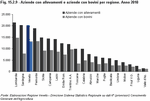
Figure 15.2.10

Figure 15.2.11

Italian agri-food products are universally renowned for their high qualitative standards, their recognisable speciality and for their ability to communicate the concept of eating good and healthy food to the world. It is not by chance that in 2010 the Mediterranean diet, of which Italy is one of the main interpreters, was recognised by UNESCO as an Intangible Heritage of Mankind; or that Italy is in first place in Europe for food products of certified origin (Note 8) (239 in 2011, 20 new products of which were registered only in the last year). The production turnover of such products has grown by 13.7% from 2009 to 2010 and the value of exported production has grown by almost 30%, involving over 80,000 operators, from producers to processors.
Of the 239 products of certified origin, 35 are produced in our region. To these products we can add the 368 traditional agri-food products (4,606 present in Italy) (Note 9), which are duly approved every year by ministerial decree and act as a sort of fan network for future products.
These products have a great tendency towards export due to a significant amount of initial commitment on the part of each producer: beginning with high quality raw materials and concluding with marketing-related policies.
Over recent years, this effort has been repaid by rapid and continual growth in Italian agri-food exports. This is above all the case in Veneto, with the exclusion of 2009 which was probably the worst year of the international financial crisis. (Figure 15.3.1)
Between 2004 and 2011, agri-food exports from Veneto grew by over 76% (55% in Italy), for a total of almost 4.5 billion Euro last year (an increase of 11% compared to 2010), covering almost 9% of our region's total international exports.
If in Veneto, as is the case in Italy, a agri-food trade deficit has now become a recurring phenomenon, it is also the case that compared to 2004, this margin has only reduced due to food industry products which have displayed positive values towards a normalised trade balance since 2010, while on the other hand, the deficit from agricultural products is increasing. (Figure 15.3.2)
More specifically, the product groups whose overall imports are lower than their exports tend to be beverages (including wine), tobacco and cereal preparations. On the other hand, the relationship is strongly in deficit for live animals, cereals, and fish and crustaceans (Figure 15.3.3)
Among the most exported products is wine which, at over 1.3 billion euros, saw its performance grow by over 60% from 2004 to 2011, covering 30% of the total agri-food products exported by Veneto over the past year. (Figure 15.3.4)
All of the 10 most exported products abroad have seen a double-figures percentage variation from 2004 to 2011. Peaking particularly well were coffee, animal food and pasta products.
With regard to recipient Countries, Germany has been our primary buyer for many years, absorbing 22% of the value of our exports over the past year. Moreover, all of the first 10 Countries in the list have shown growth values of over 20% from 2004 to 2011, with the Netherlands holding the record (112.8%). (Figure 15.3.5)
An important factor related to our exports is the concentration of agri-food product markets: half the export value comes from the first 5 Countries in the list. Our future development strategies should therefore focus on widening the markets themselves, using openings which will identify and involve all those Countries whose potential has not yet been fully developed.
Moving into provincial level detail, we can ascertain that Verona possesses almost half of agri-food exports, follow by Treviso (18.1%) and Venice (8.5%). (Figure 15.3.6), (Figure 15.3.7)
Although all provinces in Veneto are being increasingly appreciated on an international level for the products they export, the province of Padua has experienced the greatest variation between 2004 and 2011: over the course of the 7 years, its performance figures have more than doubled, predominantly as a result of the great success of its products in the beverages sector.
We now turn our attention to the Veneto agri-food product which has had the most success overseas: wine.
Italy exported 4.4 billion euros of wine across the world during the course of 2011, a year which for the first time saw the United States overtaking Germany, the historical primary buyer of Italian wines.
30% of the value exported abroad comes from our region which, at over 1.3 billion euros, confirms us at the top of the list of Italian regions for another year, having grown 15% since 2010. (Figure 15.3.8)
Growth in exports of this product has been limitless for Veneto over recent years - except during the darkest year of the crisis - literally taking off in 2010 and confirming growing international appreciation for our wines, which have exceeded our historical French rivals in quantity (though not value). (Figure 15.3.9)
Detailed data allows to identify the salient features of our wine exports: with particular regard to typology, it is bottles of wine which are most commonly sold (75%), although at 16% of total exports, it is spumante wine, which has performed best over recent years with growth rates continually exceeding double figures over the last five years, (Figure 15.3.10), (Figure 15.3.11)
As is the case for the entire agri-food sector, Germany is also our primary buyer for wine, with almost a quarter of the 2011 value and a growth of 14.8% compared to the previous year. With a growth rate which exceeds even Germany is the United States (+16.3%) and the UK (+20.3%). (Figure 15.3.12)
Even higher are the growth rates of the Czech Republic (+35.6%), Norway (+23.7%) and Sweden (+22.4%).
The latter three Countries, alongside China, Russia, Hungary, Hong Kong, Australia and Slovakia are, from within the first 25 buyers, the Countries with the highest growth from 2004 to 2011, all with values over 200%. It will be in these Countries, the majority of which still cover only a small portion of the market and where the wine culture still has much growth to do, which our foreign operators have to be able to grasp the opportunity to cultivate new slices of the market and facilitate the spread of a cultural heritage which has made Veneto renowned worldwide.
Analysing the phenomenon from a geographical point of view, since the European continent remains the greatest market for our wine with almost 70% of exports being concentrated here in 2011, it may be noted that over recent years it has mainly been the Countries of North and East Europe that have experienced growth values over 200% (Figure 15.3.13)
On the other hand, for Countries which traditionally produce and consume wine, the variation in wine exports has been decidedly lower in intensity and, in some cases (such as in Spain), it has actually been negative. If in North-East European Countries' pro capita wine consumption is growing, in these traditional wine-producing Countries a consistent fall or nevertheless a significant level of stability has emerged, as if the consumption balance is gradually moving from West to East, from the traditional wine-producers to those who do not have the opportunity to do so. (Figure 15.3.14)
Of the 239 products of certified origin, 35 are produced in our region. To these products we can add the 368 traditional agri-food products (4,606 present in Italy) (Note 9), which are duly approved every year by ministerial decree and act as a sort of fan network for future products.
These products have a great tendency towards export due to a significant amount of initial commitment on the part of each producer: beginning with high quality raw materials and concluding with marketing-related policies.
Over recent years, this effort has been repaid by rapid and continual growth in Italian agri-food exports. This is above all the case in Veneto, with the exclusion of 2009 which was probably the worst year of the international financial crisis. (Figure 15.3.1)
Between 2004 and 2011, agri-food exports from Veneto grew by over 76% (55% in Italy), for a total of almost 4.5 billion Euro last year (an increase of 11% compared to 2010), covering almost 9% of our region's total international exports.
If in Veneto, as is the case in Italy, a agri-food trade deficit has now become a recurring phenomenon, it is also the case that compared to 2004, this margin has only reduced due to food industry products which have displayed positive values towards a normalised trade balance since 2010, while on the other hand, the deficit from agricultural products is increasing. (Figure 15.3.2)
More specifically, the product groups whose overall imports are lower than their exports tend to be beverages (including wine), tobacco and cereal preparations. On the other hand, the relationship is strongly in deficit for live animals, cereals, and fish and crustaceans (Figure 15.3.3)
Among the most exported products is wine which, at over 1.3 billion euros, saw its performance grow by over 60% from 2004 to 2011, covering 30% of the total agri-food products exported by Veneto over the past year. (Figure 15.3.4)
All of the 10 most exported products abroad have seen a double-figures percentage variation from 2004 to 2011. Peaking particularly well were coffee, animal food and pasta products.
With regard to recipient Countries, Germany has been our primary buyer for many years, absorbing 22% of the value of our exports over the past year. Moreover, all of the first 10 Countries in the list have shown growth values of over 20% from 2004 to 2011, with the Netherlands holding the record (112.8%). (Figure 15.3.5)
An important factor related to our exports is the concentration of agri-food product markets: half the export value comes from the first 5 Countries in the list. Our future development strategies should therefore focus on widening the markets themselves, using openings which will identify and involve all those Countries whose potential has not yet been fully developed.
Moving into provincial level detail, we can ascertain that Verona possesses almost half of agri-food exports, follow by Treviso (18.1%) and Venice (8.5%). (Figure 15.3.6), (Figure 15.3.7)
Although all provinces in Veneto are being increasingly appreciated on an international level for the products they export, the province of Padua has experienced the greatest variation between 2004 and 2011: over the course of the 7 years, its performance figures have more than doubled, predominantly as a result of the great success of its products in the beverages sector.
We now turn our attention to the Veneto agri-food product which has had the most success overseas: wine.
Italy exported 4.4 billion euros of wine across the world during the course of 2011, a year which for the first time saw the United States overtaking Germany, the historical primary buyer of Italian wines.
30% of the value exported abroad comes from our region which, at over 1.3 billion euros, confirms us at the top of the list of Italian regions for another year, having grown 15% since 2010. (Figure 15.3.8)
Growth in exports of this product has been limitless for Veneto over recent years - except during the darkest year of the crisis - literally taking off in 2010 and confirming growing international appreciation for our wines, which have exceeded our historical French rivals in quantity (though not value). (Figure 15.3.9)
Detailed data allows to identify the salient features of our wine exports: with particular regard to typology, it is bottles of wine which are most commonly sold (75%), although at 16% of total exports, it is spumante wine, which has performed best over recent years with growth rates continually exceeding double figures over the last five years, (Figure 15.3.10), (Figure 15.3.11)
As is the case for the entire agri-food sector, Germany is also our primary buyer for wine, with almost a quarter of the 2011 value and a growth of 14.8% compared to the previous year. With a growth rate which exceeds even Germany is the United States (+16.3%) and the UK (+20.3%). (Figure 15.3.12)
Even higher are the growth rates of the Czech Republic (+35.6%), Norway (+23.7%) and Sweden (+22.4%).
The latter three Countries, alongside China, Russia, Hungary, Hong Kong, Australia and Slovakia are, from within the first 25 buyers, the Countries with the highest growth from 2004 to 2011, all with values over 200%. It will be in these Countries, the majority of which still cover only a small portion of the market and where the wine culture still has much growth to do, which our foreign operators have to be able to grasp the opportunity to cultivate new slices of the market and facilitate the spread of a cultural heritage which has made Veneto renowned worldwide.
Analysing the phenomenon from a geographical point of view, since the European continent remains the greatest market for our wine with almost 70% of exports being concentrated here in 2011, it may be noted that over recent years it has mainly been the Countries of North and East Europe that have experienced growth values over 200% (Figure 15.3.13)
On the other hand, for Countries which traditionally produce and consume wine, the variation in wine exports has been decidedly lower in intensity and, in some cases (such as in Spain), it has actually been negative. If in North-East European Countries' pro capita wine consumption is growing, in these traditional wine-producing Countries a consistent fall or nevertheless a significant level of stability has emerged, as if the consumption balance is gradually moving from West to East, from the traditional wine-producers to those who do not have the opportunity to do so. (Figure 15.3.14)
Figure 15.3.1

Figure 15.3.2
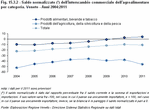
Figure 15.3.3
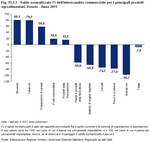
Figure 15.3.4
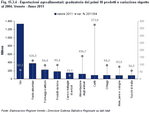
Figure 15.3.5
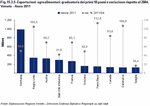
Figure 15.3.6

Figure 15.3.7

Figure 15.3.8
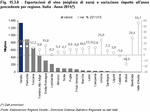
Figure 15.3.9
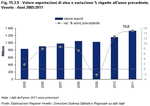
Figure 15.3.10

Figure 15.3.11

Figure 15.3.12
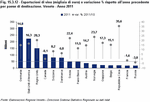
Figure 15.3.13
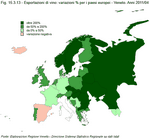
Figure 15.3.14
